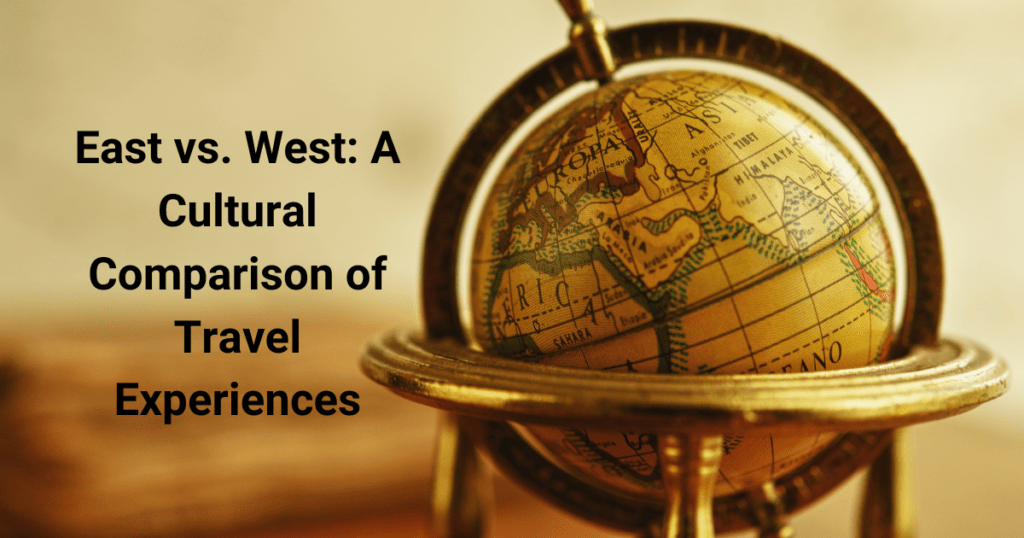Introduction:
Traveling is not only about exploring new destinations and witnessing breathtaking landscapes; it is also about immersing ourselves in different cultures and experiencing their unique way of life. When it comes to cultural experiences, the East and the West offer contrasting but equally fascinating encounters for travelers. Let’s delve into a detailed cultural comparison of travel experiences between these two regions.
Language Barrier:
Communication plays a crucial role in any travel experience. While English is widely spoken in Western countries, language barriers can be more pronounced in the East. Learning key phrases or hiring translators might be essential for seamless interactions. To hire a translator, click here.
Hospitality:
Both the East and West are known for their warm hospitality, but they express it in different ways. In the West, people are generally more individualistic, while the East values collectivism, leading to a stronger emphasis on generosity and communal support.
Cuisine:
The culinary experiences in both regions are incredibly diverse. Western cuisine is famous for its variety, distinct flavors, and international influences. On the other hand, Eastern cuisine offers a tapestry of tastes, often characterized by complex flavors and unique cooking techniques.
Religious Traditions:
The East is deeply rooted in religious traditions, such as Buddhism, Hinduism, and Islam, which shape daily life and social customs. In contrast, the West is more secular, with diverse religious practices and a greater emphasis on individual freedom of choice.
Architecture:
The architectural landscape in the East and West showcases contrasting styles. The East is renowned for its intricate and ornate designs, reflecting its historical and cultural heritage. In the West, architecture often focuses on functionalism and minimalist aesthetics.
Dress Code and Etiquette:
Eastern cultures tend to be more conservative when it comes to dress codes and etiquette, emphasizing modesty and respect. The West, on the other hand, embraces more relaxed and casual attire, allowing for greater individual expression.
Festivals and Celebrations:
Both regions have their own unique festivals and celebrations, each reflecting their cultural values. In the East, festivals like Chinese New Year and Diwali are colorful and vibrant, while the West celebrates events such as Christmas and Easter with traditions rooted in religion and folklore.
Sense of Time:
Eastern cultures often embrace a more flexible and relaxed approach to time. Punctuality is not as highly valued as in Western cultures, where adhering to schedules and being prompt is considered essential.
Concept of Personal Space:
The concept of personal space can vary significantly between the East and the West. In the West, personal boundaries are highly respected, and interactions are generally more reserved. Eastern cultures, however, tend to be more communal, with less emphasis on personal space during social interactions.
Art and Aesthetics:
Both regions boast rich artistic traditions but distinct styles. The East celebrates calligraphy, intricate painting, and traditional crafts, while the West focuses on techniques such as realistic painting, abstraction, and modern art movements.
Education Systems:
The educational systems in the East and West differ greatly. The East places a strong emphasis on discipline, memorization, and academic achievement, while the West values critical thinking, creativity, and holistic development.
Work Culture:
Work habits and expectations also vary between the East and West. The West emphasizes work-life balance, flexible schedules, and a more informal office environment. The East values dedication, hierarchy, and adherence to protocols.
Concept of Beauty:
The perception of beauty is subjective and culturally influenced. In the East, beauty is often associated with smooth, fair skin and delicate features. In the West, a broader range of physical features is considered attractive, emphasizing individuality and diversity.
Transportation Systems:
Transportation infrastructure in the East and West reflects their respective priorities. While Western countries invest heavily in well-connected road networks and public transportation, Eastern countries often embrace extensive railway systems and efficient public transport.
Technology Adoption:
Western countries are known for their technological advancements and early adoption of innovations, while Eastern countries have seen rapid growth in technology adoption in recent years, particularly in sectors such as e-commerce and mobile payments.
Environmental Sustainability:
The East and West diverge in their approaches to environmental sustainability. While the West focuses on reducing carbon footprints and conservation efforts, the East places a stronger emphasis on sustainable practices within their cultural and religious beliefs.
Social Etiquette:
Social norms and etiquette differ between the East and the West. The East values respect for elders, humility, and avoiding confrontation, while the West is more direct and assertive when expressing opinions or disagreements.
Music and Performing Arts:
Both regions boast unique musical and performing arts traditions. The East cherishes classical forms like Indian classical music and Chinese opera, which have deep historical roots. The West celebrates various musical genres and theater styles, often pushing boundaries and embracing experimentation.
Concept of Leisure:
Leisure activities differ between the East and West. Western cultures place a strong emphasis on individual pursuits, recreational sports, and personal hobbies. Eastern cultures prioritize communal activities, such as group outings, karaoke, and communal dining experiences.
Cultural Preservation:
The East and West approach cultural preservation differently. The West often focuses on preserving historical monuments and artifacts, while the East places greater emphasis on preserving intangible cultural heritage, such as traditional ceremonies and practices.
Conclusion:
In conclusion, comparing and contrasting travel experiences in the East and West is a fascinating exploration of cultural diversity. From language barriers to architecture, cuisine to festivals, and traditions to societal norms, travelers are bound to encounter a multitude of rich experiences that shape their understanding of the world. Embracing the nuances and unique aspects of both regions allows for a truly immersive and enlightening travel experience, illuminating the beauty of our diverse world. For travel-related blogs, click here.


